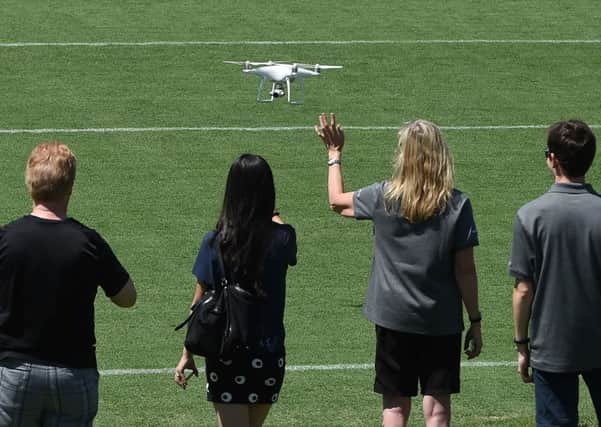Colin Houston: Follow the rules on drone operation


With passenger air traffic set to grow over this holiday season, is there also room for drones in the summer skies above Scotland? Emphatically “yes” says NATS’ Colin Houston – as long as drone pilots use their heads and follow the rules.
School summer holidays are nigh and, as the weather slowly improves, drone enthusiasts will soon be able to take to the skies as they pilot their drones, exploring the countryside from the air.
Advertisement
Hide AdAdvertisement
Hide AdDemand to own and fly Remotely Piloted Aircraft Systems (RPAS, or drones) for commercial purposes or simply for pleasure is steadily climbing and, for many, the summer holidays represent the perfect time to take their drones for a spin in the great outdoors.
As might be expected of aviation enthusiasts, NATS is excited by developments in this sector of the aviation industry and is enthusiastic about drones in general. Powered by sophisticated technology, drones can vary significantly in size, from RPAS that can fit in the palm of a hand to commercial crafts the size of a Boeing 737 – and this is a stark reminder that no matter how big or small, essentially all drones are aircraft and as such must be operated safely and responsibly with regard to people and property on the ground as well as other airspace users.
With our specialist aviation history and wealth of experience, NATS is well placed to offer advice and training for pilots of drones and we have recently launched an instruction course for RPAS operators that is accredited by the Civil Aviation Authority (CAA).
As a first step to obtaining the permissions required to fly drones for commercial purposes the tailored training course, run at NATS’ Prestwick control centre by air traffic control professionals, is perfect for pilots looking to earn money by operating their drones. Of course, hobbyists and drone enthusiasts are also welcome to join us, to hone their skills and gain practical tips on safety and best practice – and many do.
Over three days, participants study a variety of subjects relating to drone flying, including aviation law, meteorology and navigation, the principles of flight and RPAS best practices. To qualify as a delegate, pilots must demonstrate that they are already proficient in flying their drone in a confined, relatively small area.
Because NATS is dedicated to ensuring today’s RPAS pilots operate their drones safely and responsibly, the course is designed to instruct operators to a level that will satisfy the safety and operational requirements outlined by the CAA; it concludes with an on-the-spot practical flying assessment judged to CAA-approved standards that delegates must pass to achieve CAA permissions.
But, in case time is tight for hobbyists keen to get their drones airborne and make the most of the long, light summer days, we have put together a checklist of essential RPAS dos and don’ts to help keep everyone safe in the skies.
As airspace users, drone pilots have an obligation to consider the needs of others in the air and a responsibility to take all reasonable precautions to avoid creating potentially unsafe incidents. Meticulous pre-flight checks to ensure the drone is in excellent working order and responsive to its pilot’s remotely-given commands is essential, as is familiarity with the area in which the flight is to take place (a street-view internet mapping service is great for armchair reconnaissance).
Advertisement
Hide AdAdvertisement
Hide AdSpecifically, drones must not be flown above a height of 400 feet; they must remain at least 50 metres distant from any person, vehicle, building or structure; and they must not be flown (at any height) directly above people. RPAS operators must at all times be able clearly to see their drone, and pilots must not let their drone fly further away from them than 500 horizontal metres in their direct line of sight. Drones are not permitted within 150 metres of congested areas such as street, towns, cities and parks, and specific permission must be sought from the CAA for all commercial RPAS flights that may result in financial gain.
Every drone pilot, from the enthusiastic hobbyist to the most seasoned commercial RPAS operator should always bear in mind that they are ultimately responsible for the safety of each and every flight they undertake and they must ensure that collisions with people or other objects can be safely avoided at all times. Failure to comply with any of the CAA’s Dronecode rules may lead to criminal prosecution, while the operation of a drone fitted with camera functionality could leave a pilot liable to prosecution under UK privacy laws.
• Colin Houston is head of Prospective Centre Services, NATS Prestwick